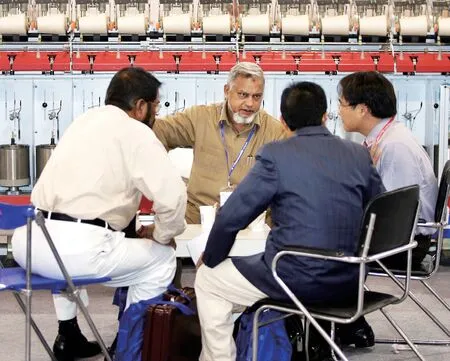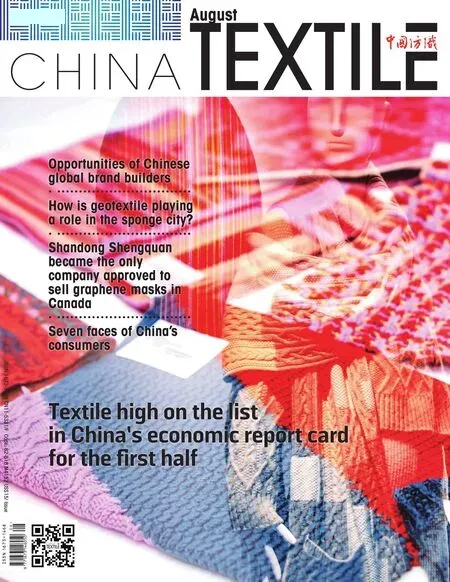Foreign trade trend in the second half of the year
In May this year, China’s exports showed nega—tive growth for the first time, and the downward trend of growth will continue. From the beginning of the year to April, monthly export growth of textile and apparel was achieved, but the growth rate has been falling down month by month since March, with a negative growth of 16.8 percent for the first time in May. Excluding pan—demic prevention materials, the export increased by 72.8 percent in that month, which was lower than the earlier period. Since the export peak was in the second and third quarters of last year, it is preliminarily predicted that the monthly export growth rate will continue to slow down or even decline until the end of the third quarter.
The global vaccination rate increased by 12 percent month—on—month, and external demand is expected to pick up further in the second half of the year. As of June 24, more than 2.8 billion doses of novel coronavirus vac—cine have been administered worldwide, with an inocula—tion rate of 22.59 percent, up 12 percentage points from May 24, according to the University of Oxford. The cover—age rate in developed economies is above 40 percent.Experts predict that, based on the current vaccination rate, the European Union will be able to achieve herd im—munity in the second half of the year, when the demand for textile and apparel in major economies will further return to normal.
From January to May, China’s textile and apparel trade value reached USD 126.53 billion, up 18.3 percent year—on—year. Among them, exports reached USD 115.11 billion, up 17.7 percent year—on—year, or 15.7 percent over the same period in 2019; imports reached USD 11.42 bil—lion, up 24.6 percent year—on—year, or 13.2 percent over the same period in 2019. The accumulated trade surplus reached USD 103.69 billion, up 17 percent year—on—year,or 15.9 percent over the same period in 2019.
In May, the trade of China’s textiles and apparel was USD 27.01 billion, down 13.5 percent year—on—year, up 4 percent compared with the same period in 2019, and up 3.2 percent month—on—month. Among them, exports were USD 24.84 billion, down 16.8 percent year—on—year,up 4.3 percent compared with the same period in 2019,or up 4.5 percent month—on—month; imports reached USD 2.17 billion, up 59.1 percent year—on—year, up 1 per—cent from the same period in 2019 and down 9.4 percent month—on—month. The trade surplus for the month was USD 22.67 billion, down 20.4 percent year—on—year, up 4.6 percent from the same period in 2019 and up 6 per—cent month—on—month.
Textiles is the main drop in exports
With a slight improvement in external market de—mand, a continuous decline in the export of pandemic prevention materials, a large year—on—year base and other factors, textile and apparel exports continued to rise in May. Exports in that month maintained a month—on—month growth, but exports showed a negative growth for the first time in the year. Compared with the same period in 2019, the growth rate was increased by 4.3 percent,which was significantly lower than the previous period.

The decline was mainly driven by textiles, which fell by 40.8 percent, up 5.3 percent from the same period in 2019. Apparel grew 37.6 percent, up 3.5 percent com—pared with the same period in 2019.
Weak follow-up growth in exports to the EU and Japan
Exports to the United States and ASEAN markets maintained relatively stable and sustainable growth, while exports to the European Union and Japan continued to grow weakly. In the second month of the second quarter,the growth momentum of textile and apparel exports to major markets weakened. China’s exports to the four key markets and bulk commodities basically showed a slow—ing or declining trend, and it is expected that this trend will remain until the end of the third quarter.
As the largest export market of China’s textile and apparel, the stability of the U.S. market is still outstanding.From January to May, China’s export to the U.S. reached USD 20.02 billion, up 23.3 percent year—on—year and 23.4 percent compared with the same period in 2019.Among the key commodities, knitted garments increased by 62 percent, down by 1.8 percent compared with the same period in 2019, and basically recovered to the pre—pandemic level.
EU market demand picked up, but not enough mo—mentum. From January to May, China’s textile and ap—parel exports to the EU reached USD 16.57 billion, down 15 percent year—on—year and up 18.5 percent over the same period in 2019. Among them, the growth of knitted garments was 30.9 percent year—on—year and 6.7 per—cent compared with the same period in 2019. In May, the export growth momentum was insufficient, with a decline of 16.4 percent.
Japan is a volatile market with limited room for growth. From January to May, China’s textile and apparel exports to Japan decreased by 8.9 percent year—on—year and increased by 9.2 percent compared with the same period in 2019. Among them, the growth of knitted gar—ments was 8.4 percent year—on—year and 2.7 percent lower than the same period in 2019.
ASEAN markets are relatively stable, and exports have maintained a double growth. From January to May,China’s textile and apparel exports to ASEAN increased by 42.2 percent year—on—year and 23.4 percent over the same period in 2019. Yarn and fabric were up 41.4 per—cent year—on—year and 5.9 percent higher than the same period in 2019.

The share of Chinese products in the three key mar—kets is still at a high level, and its share in the European and American markets is still higher than that of the same period in 2020 and 2019, while its share in the Japanese market has fallen slightly.
From January to March, the 27 EU countries import—ed USD 33.01 billion from the world, an increase of 10.7 percent, and imports from China increased by 34.2 per—cent. China’s share accounted for 35.1 percent, which was 6 percentage points and 5.2 percentage points higher than the same period in 2020 and 2019, respectively.
From January to April, the United States imported USD 42.79 billion from the world, an increase of 25.1 per—cent, and imports from China increased by 43.4 percent.China’s share accounted for 30.9 percent, which was higher than the same period in 2020 and 2019. Among them, textiles accounted for 36.8 percent, lower than the same period in 2019 and 2020, and apparel accounted for 28.8 percent, both higher than the same period in 2019 and 2020.
From January to April, Japan’s imports from China fell by 4 percent, and China’s share was 55.1 percent, which was lower than in 2020 and the same period in 2019.Among them, textiles accounted for 57.8 percent, lower than the same period in 2020, higher than the same pe—riod in 2019; apparel accounted for 55.2 percent, higher than the same period in 2020, lower than the same pe—riod in 2019.
China-India trade on rise despite chill in bilateral ties
The China—India bilateral trade in the first half of the year totalled USD 57.48 billion, up 62.7 percent year—on—year, perhaps the highest in recent years amid the Ladakh impasse and the COVID—19 pandemic, according to data released by China’s Customs.
According to data released by China’s Customs,India’s exports to China reached USD 14.724 billion, up 69.6 percent year—on—year in the first six months and In—dia’s imports from China amounted to USD 42.755 billion,up 60.4 percent. China’s overall trade in the first half of the year rose by 27.1 percent year—on—year to 18.07 tril—lion yuan (about USD 2.79 trillion) in the first six months,according to the customs data.
The growth marks an increase of 22.8 percent from the pre—pandemic level in 2019. Exports jumped 28.1 percent from a year earlier, while imports climbed 25.9 percent in yuan terms. The trade deficit for the first six months of the year stood at USD 28.03 billion,up 55.6 percent year—on—year, according to official sources.
While the COVID—19 second wave has resulted in a major increase in China’s exports, especially the oxygen concentrators, ventilators, monitors, and medical ma—terials and drugs, India’s exports to China were boosted by the increase in iron ore, steel, aluminium and copper.From January to April this year, China imported a total of 20.28 million tonnes of iron ore from India, an increase of nearly 66 percent from the same period of last year,accounting for nearly 90 percent of India’s total iron ore export, the state—run Global Times reported.
It quoted the data released by the Chinese Foreign Ministry stating that China had exported more than 26,000 ventilators and oxygen generators, more than 15,000 monitors, and nearly 3,800 tonnes of medical materials and drugs to India in April. Last year the India—China trade totalled to USD 77.67 billion, which was lower than the USD 85.47 billion in 2019.
Exports of pandemic prevention materials declined further
Exports of pandemic prevention materials declined further, and apparel exports maintained a good growth trend. In May, the export of textile pandemic prevention materials continued to decline, and the decline was fur—ther expanded. The decline of medical masks and pro—tective clothing reached 93.4 percent and 86.4 percent,respectively, leading to a 75.1 percent and 44.7 percent decrease of the cumulative export from January to May,respectively.
Textiles were affected by the decline in mask exports,which fell by 40.8 percent in May and increased by 71.5 percent in real terms excluding masks, up 1.6 percent compared with the same period in 2019. The total growth of yarn and fabric was 82.3 percent, down 5.6 percent compared with the same period in 2019. From January to May, the cumulative export of textile products decreased by 2.9 percent, and the actual growth rate increased by 48.3 percent excluding masks, 9.4 percent compared with the same period in 2019, of which the total growth rate of yarn and fabric was 45 percent, 2 percent com—pared with the same period in 2019.
Exports of major provinces and cities slowed down year-on-year
From January to May, the export of China’s key ex—port provinces, cities (regions) still maintained growth,among which the top five provinces of Zhejiang, Jiangsu,Guangdong, Shandong and Fujian all achieved rapid growth year—on—year and compared with the same period in 2019. However, in a single month, the export growth trend has dropped significantly. Among the top five provinces and cities, Jiangsu and Guangdong, as well as Guangxi, Hunan and Henan in the central and western regions, have seen negative growth year—on—year and compared with 2019, while the growth rate of most other regions has also dropped significantly.
This year’s textile imports are behind the year before
Apparel imports continued to grow, and the gap between this year’s textile imports and the same period in 2019 was further widened. Apparel imports showed a good trend of development and achieved sustained and steady growth. In May, apparel imports increased by 80.7 percent year—on—year and 34.2 percent compared with the same period in 2019, among which knitted garments increased by 85.9 percent and 27.8 percent respectively.From January to May, apparel imports increased by 58.9 percent year—on—year and 46.2 percent compared with the same period in 2019.
Monthly textile imports picked up slightly year—on—year, up 48.1 percent in the same month, 18 percentage points higher than the previous month, but 12.3 percent lower than the same period in 2019, the decline continues to expand compared with the previous month. Among them, yarn and fabric fell 15.3 percent. From January to May, textile imports increased by 7.4 percent year—on—year, and decreased by 3.1 percent compared with the same period in 2019.
Textiles grew 7.4 percent year—on—year, down from the previous month’s cumulative increase, and down 3.1 percent compared with the same period in 2019.
Cotton imports fall and prices rise
Cotton imports continued to fall in May, with 173,000 tons imported. Imported cotton prices have been rising month by month, rising to an average of USD 1,980 per ton in May, the highest since last year.
From January to May, the import of cotton grew rapidly, with the total import from the world reaching 1.374 million tons, up 70 percent year—on—year. Im—ports from the United States, Brazil, India and Burkina Faso all increased, while imports from Australia fell by 70 percent.
- China Textile的其它文章
- Spandex price survey: demand greater than supply
- Supply and demand of yarn market forecast in the second half of year
- As price goes up and down, how the fabric enterprises survive?
- 2020/2021 China garment market development report
- Dye production decreased but is expected to pick up
- Prosperity index of the national textile and apparel specialized market declined overall

